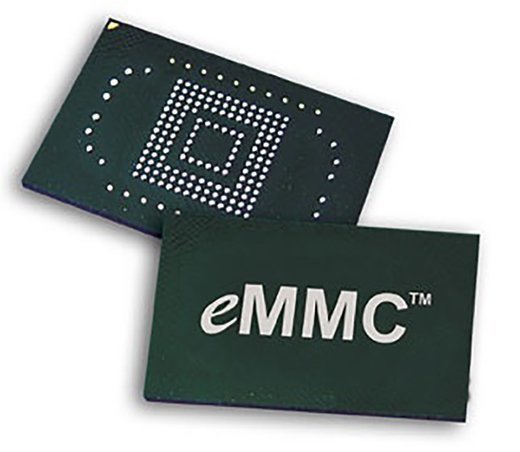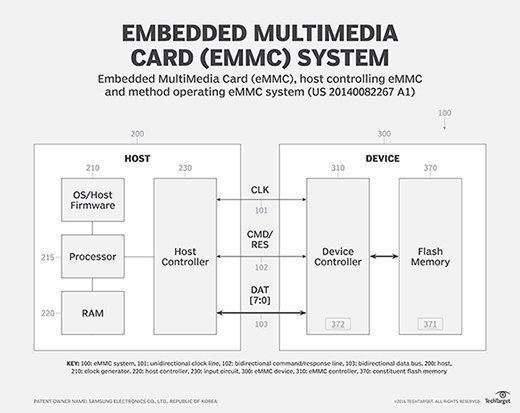What is an embedded MultiMediaCard (eMMC)?
An embedded MultiMediaCard (eMMC) is a small storage device made up of NAND flash memory and a storage controller. The MultiMediaCard Association and JEDEC developed the eMMC standard for embedded flash memory applications in 2006.
The technology is intended for use in portable devices, such as cellphones and tablets, and more recently, it's being used in sensors connected to the internet of things (IoT). Both the flash memory and controller are contained on a single integrated circuit (IC) that's embedded permanently in a device.

How do eMMCs work?
An eMMC acts as the primary storage for portable devices. That storage can be expanded with a removable Secure Digital (SD) card or microSD multimedia card. However, eMMC is the sole storage for very small sensors connected to IoT devices.
The eMMC IC is attached through a parallel connection directly to the main circuit board of whatever device is using it to store data. By using an integrated controller in the eMMC, the device's central processing unit (CPU) doesn't have to handle placing data into storage because the eMMC's controller and related firmware take over that function. This frees the CPU -- a lower-speed chip with low power consumption compared with ones used in PCs or servers -- for more important tasks. By using flash memory, the entire IC-based eMMC draws little power compared with a spinning disk.
While the connection to the main board of the device is parallel, the updated eMMC specification enables a data transfer rate up to 400 megabytes per second. That's comparable to a solid-state drive (SSD) using a Serial ATA (SATA) connection.

Use cases for eMMC
The mobile device industry is the primary eMMC user; the technology shows up in smartphones, tablets and laptops. The largest-capacity eMMC available is 512 gigabytes (GB). They're available from several vendors and often used in lightweight notebook computers. The sensors built into IoT devices to collect data rely on smaller eMMC integrated circuits.
The auto industry is also making use of eMMCs, as more vehicles have onboard entertainment and navigation systems. Companies such as SanDisk have introduced ruggedized eMMCs to stand up to the environmental and stress demands of industrial and automotive use. Ruggedized eMMCs cost more than the standard eMMCs.
Who manufactures eMMCs?
According to Global Market Insights, following is a sampling of leading eMMC manufacturers:
- ADATA Technology.
- Kingston Digital.
- Kioxia.
- Renesas Electronics.
- Samsung Electronics.
Pros and cons of eMMC
The advantages of eMMC technology include the following:
- A large data storage capacity, up to 512 GB.
- A compact form factor that makes it ideal for small consumer electronics and other electronic devices.
- A low cost compared with other technologies.
The following are some of the drawbacks of these embedded systems:
- Slower read/write speeds than technologies such as Universal Flash Storage (UFS) and non-volatile memory express.
- A limited number of write cycles.
- Not ideal for high-performance and compute-intensive applications.
- Not as reliable as other architectures, such as SSDs.
UFS: Replacement for eMMC
In 2011, JEDEC released the UFS standard, intended to replace both eMMC and SD flash memory cards with a single standard. In 2015, Samsung announced its first UFS embedded memory for portable devices, in sizes up to 128 GB. In 2016, Samsung announced its first removable SD cards based on UFS.
UFS has several advantages over eMMC:
- Full-duplex interface. UFS uses a full-duplex interface, which permits concurrent read/write operations. The half-duplex interface that eMMC uses limits read/write activities to only one at any time.
- Low-voltage differential signaling. UFS uses the LVDS interface, which improves transmission efficiency. LVDS isn't in eMMC.
- Faster speeds. UFS is designed for faster read/write speeds than eMMC, which uses an eight-lane parallel and half-duplex interface. UFS is also based on the Small Computer System Interface architecture and uses SCSI tagged command queuing, which also improves transfer speeds and overall performance.
Since eMMC's version 5.1A release in 2019, development has slowed in comparison with UFS. JEDEC, which handles both specifications, has gradually shifted its focus to UFS. However, eMMC continues to be used and provides a viable and cost-effective option for applications in edge computing and IoT.
Learn everything you need to know about flash memory's growing role in the enterprise.






